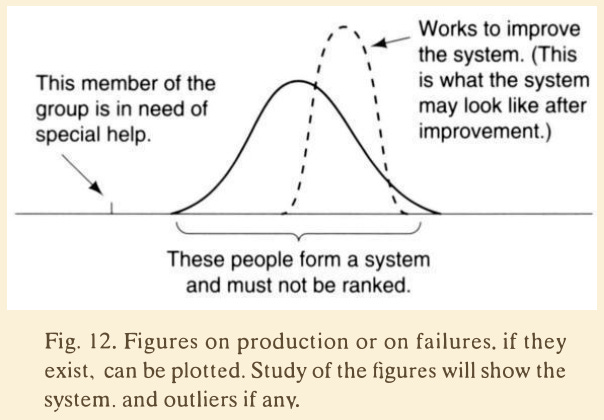Variation in People
Managing for the Optimization of Profit and Joy in Work
Role of a Manager of People: This is the new role of a manager of people after transformation.
3. A manager of people understands that people are different from each other. He tries to create for everybody interest and challenge, and joy in work. He tries to optimize the family background, education, skills, hopes, and abilities of everyone.
This is not ranking people. It is, instead, recognition of differences between people, and an attempt to put everybody in position for development.
9. He will try to discover who if anybody is outside the system, in need of special help… Special help may be only simple rearrangement of work. It might be more complicated. He in need of special help is not in the bottom 5 per cent of the distribution of others; he is clean outside that distribution. (Fig. 12.).
- Dr. W.E. Deming. The New Economics, 3rd. ed. (p. 87)
The most important act that a manager can take is to understand what is important to an individual. Everyone is different from everyone else. All motivated to a different degree extrinsically and intrinsically. This is why it is so vital that managers spend time to listen to an employee to understand whether he is looking for recognition by the company, or by his peers, time at work to publish, flexible working hours, time to take a university course. In this way, a manager can provide positive outcomes for his people. and may even move some people toward replacement of extrinsic motivation with intrinsic motivation.
- Ibid. (p. 76)
The aim of management, management’s job, is to enable everybody to enjoy his work.
- Dr. W.E. Deming as quoted in Neave, Dr. Henry. The Deming Dimension. (p. 198)
Once upon a time, a dozen or so years ago when I worked for Microsoft Consulting Services, I found myself in a situation best described by the cliched expression “between a rock and a hard place”. I was hired for my expertise in a product of theirs that in a year or so was going to be upgraded to a significant new release. In the period between the sunset of the old and sunrise of the new was a long, dry desert while customers waited for access to the next early beta that I could help them learn and implement. Consequently, I found myself riding the pine with no billable work, and after a time put on a Performance Improvement Plan with unreachable “utilization targets” no one could hit in the best of circumstances, let alone what I was facing. I was eventually left with no choice but to resign.
I was caught within a system that featured some of the worst management practices, some of which have been thankfully retired since my departure. My performance was dictated by other components which I had little influence or control over, including product groups, sales, marketing, and phalanxes of HR and engagement managers. Advising on how to improve or change things was out of the question and beyond my station. In contrast to Deming’s Figure 12 below, I wasn’t so much in need of special help as I was of needing to be excised so as to improve the quarterly profit margin.
What would have been different had the leadership and management been leading using a Deming lens? Some examples:
Variation of customer demands for service would be tracked and consultants not held to arbitrary utilization targets (a form of Management by Objective, which is a failure of management to understand interdependence between parts of the system)
Managers closest to consultants would be continually learning about their team’s interests and how they want to improve themselves and their system. I had a lot to say about improving the engagement model, for example, which frequently constrained how consultants could creatively meet customer expectations.
Instead of choosing to “rank and yank” the bottom 10% of performers according to utilization (read: management by fear), leadership, understanding some theory of variation, would seek to improve their systems to keep good people either by redesigning the workflow with them or helping them to move to other places in the organization. In other words, to unlock their intrinsic motivation rather than demotivating them through extrinsic means.
Reflection Questions
Consider Deming’s words above in relation to the prevailing style of management practiced in your organization, especially now in the time of hybrid and remote work. Why do you think people are wanting to avoid coming back to the office except under duress? What are they escaping? How has management evolved? Are any proposed or ongoing changes aligned with what Dr. Deming advises, or is it more of the same in different packaging? What small change could be made today or tomorrow that would enable your team or department to start on path toward recovering joy in work for everyone? What would be the benefits of leading this way? What are the consequences of choosing to avoid doing so? Hint: As Dr. Russell Ackoff would advise, you don’t always get what you want by getting rid of what you don’t want, a nod to avoiding simple, local optimizations that ignore whole system impacts.



